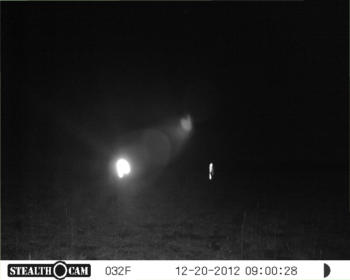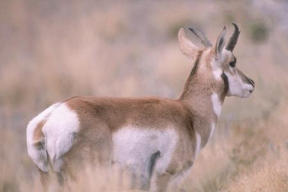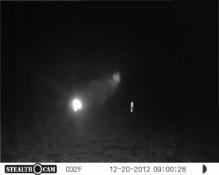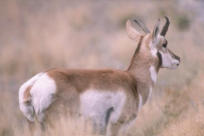


© 2014-2021 Copyright by P. K. H. Groth, Denver, Colorado, USA All rights reserved - See contact page for for permission to republish article
excerpts.
Educational Hunt Stories - Page D
Drones and Elk: The Jackson Hole Wyoming National Elk Refuge provides winter quarters of elk escaping
unlivable backcountry conditions and forage limitations. The elk are physiologically very stressed after a
winter of browsing low nutrition winter food. They were living off declining summer-stored fat in the
energy-consuming Montana cold an deep snow. The less stressed they remained, the better for their
survival to spring and the birth of strong offspring/progeny.
Enter this situation by David A. Smart, a misnomered naturalist of 45 from Washington DC. He flew a
drone over the elk to photograph them. The1, 500 herd stampeded half a mile trough deep snow.
Although realizing his mistake and being very apologetic, he was cited for disturbing wildlife and fined
$280 (it could have been $5,000). Be sensitive to the survival needs of wildlife. (Elk Denver Post February
26, 2017)
It is illegal in Colorado to use drones while hunting. It is also not a part of fair chase (play) hunting.
A Prairie Duel: We are fortunate to use a remote cabin on a Wyoming
ranch. The idleness there is wonderful. We are force to relax and in
doing so have time to study nature during its daily cycles. The
observations of how animals live makes us better hunters. The cabin
has a windowed door and an opposing single window. These windows
are spy stations, transports to what is happening outside. Linda scans
the south, and I kick back in a chair to read and observe the north
panorama.
One spring (Early June) during brunch a doe antelope slowly plodded down a seismic truck road. It fill and
then thrashed around on one side and then another. This tantrum repeated two more times. Our
curiosity binoculars studied the doe as a new life plopped to earth. Motherly, the doe cleaned the fawn as
it bobbed its head toward the new-found sunlight. Then the mother repeated the birth gyrations on the
ground and another being entered our realm.
Coyotes are predators of fawns, and in the spring, they are ever slinking through the sagebrush where
they had seen doe antelope graze. While very young antelope can run, they cannot run far nor as fast as
the mother. The does issue a verbal command and the fawns fall like a rock to nestle and freeze in a
football sized, camouflaged mound. The mother tries to lead the coyote(s) away.
Two doe antelope had a different plan one morning. One doe charged the approaching coyote and tried
to trample it. The invader got half the idea and ran, and ran, and ran with the doe hot on his heels. The
villain was then chased to a fence where he found no relief. The second doe stampeded the coyote in
circles until it was tiring. She passed it under the fence to the now rested first doe. This fence pass-off
lasted a good twenty nonstop minutes. That coyote was slowing, his tongue hanged out, and his ears
were laid back. Canine creativity dawned. He ran along the fence line dodging posts like a slalom skier
until the two sister escorts had run him out of their valley and over the hill. Motherly love or survival of
the species instinct?
Mentoring boys and The Friendly Spook: In my book I mention two boys I mentored for hunting and
backcountry nature appreciation. I am tickled at the flood of chain-linked memories that creep out of my
cerebellum and must indulge you with one more. Scott was a perfect scholar, getting a 100 %score on his
SAT test. Needless to say, he was amazing to mentor. He closely, unobtrusively observed what I (we) were
doing and quickly perceived the next steps of a new chore or wildlife experience. I got a taste of his long-
range perceptions on the second elk hunt. We were sitting, resting on our backpacks at the trailhead. We
had hunted deer three weekend days and Scott had to get back to school. He noticed the pickup truck
lumbering down the hill toward us.
Scott drawled, “That is either an ugly but well trained dog driving that pickup, or a cadaver.” The truck
parked and I discretely glanced in the cab and agreed. The driver sat there looking straight ahead for a
while. Then he struggled to open the door, and untangled himself from the steering wheel and seatbelt.
Clawing the truck as a support, the apparition tottered to walk toward us. An obviously cherished, beaten-
up conical hillbilly hat below which emerged ruffled white hair crowned this spook. The few remaining ill-
kept teeth were tobacco brown. These visual condiments perfectly framed his wrinkled pallid face, on
which his jowls flinched with each labored short step toward us. “Good Morning gentlemen!” he said in a
friendly, warm, thick southern accent. He swabbed us out about the back country hunting area that we
realized was not even a remote dream for him, becasue of his handicap. In later years I heard stories of
the friendly cuss – stories that filled in his anatomical history and explained his world view conditions.
“Oscar” came with a large party from Arkansas. In his early elk hunting years he spent a lot of time in
camp conjuring the hunt. Camp was where the booze was, and perhaps not too gradually it took its toll.
He became relegated to mule and horse handler. His other duty was to make provision, hay and stock
runs to town fifty miles away. Must of the trip was on rubbly dirt, wash-boarded curvy mountain roads.
He was relieved of this duty when he exited the dirt road on a curve, taking the tuck and a trailer of
horses over the brink.
I met one of “Oscar’s” hunting companions many years later and he filled me in on their hunting club time
journey. It seems the club organized around an abandoned, empty, creek side Arkansas oil tank. A door
torch-cut into the tank and some obvious cleaning created the perfect man cave. Old furniture
complimented the petroleum perfume. There was one ceiling light bulb. To use too many volts may have
alerted the farmer, because their illegal line tap may have been noticed. It was in this luxurious wonder
that the group languished after deer and rabbit hunts, probably perspired, more probably got snockered
at day’s end, and got used to steel wall echoes. Now to “Oscar’s” ambulatory handicaps and the partial
reason for the truck wreck.
It seems “Oscar” liked good ol’boy cooperative rabbit hunting. Years ago he and a friend saw a prime hare
scurry into a field irrigation pipe. An execution plan was instantly hatched without much (any) necessary
planning. Oscar declared he would stand the pipe on end and shake out the rabbit. His partner was to be
vigilant and shoot the beast. Oscar picked up the twenty-foot aluminum pipe, braced his knees against it,
and tipped it skyward. Before the victim fell out, but Oscar’s ankles were fried with 7,000 volts from the
farmer’s overhead electric wire. He never walked correctly again, but he was always invited to elk camp
where he could to hobble around and do chores. He was cherished by all his buddies of the oil tank
hunting club. (The loss of brake foot control was a partial reason for the truck wreck. You can guess the
rest.)
Getting Nowhere Going to Camp: I had eaten dinner and was
resting in my tent. I listened to a mounted hunter plod by.
Then another five minutes later he passed by in another slow,
faltering ride. And then another! What was going on? I
extinguished my lantern and peered out the tent door. There
was a fellow having some horse difficulty, stumbling around
and around in a 110 yard circle. I slipped on my boots and
intercepted the rider on another lap. He was looking for the
trailhead which was over a quarter of a mile away. And at that
trailhead there was no large pond like the one he was circling. I
asked him to raise his headlight above the eyelashes of the horse (so the horse was not walking in a light
fog), and then led him to a tree line that should unfailingly get him to the trail head. Story motto? Always
know the way home if you hunt until dark.
Note: The photo of the horse rider was captured by a trail cam. The bright lights are of two of our passive
lures being illuminated by the rider’s headlamp.
Perfecting a Two Minute Bath: It was only a small, still-water wilderness pond. We used it for a water
source our first two years of elk hunting. Our children were interested in the red sediment in their Vienna
Sausage aluminum can cups that magically occurred when we boil-treated the water. The micro-shrimp’s
color mesmerized the children, who wondered if the shrimp would grow to good eating size. We later
found a spring water source, at which we sometimes had to demand access from a claimant outfitter. A
backpack of gallon jugs and two more in each hand was a 64 pound haul, but the effort provided several
days of clear water.
The cold tent pond then became a Roman bath for sweaty, stout-hearted snow-bound hunters. A strip
down, preliminary cold-water bottle soap bath away from the water, a “plunge” into the foot deep water, a
race to the tent portal with juged water, final foot cleansing of muck and snow, a tee-shirt dry, and leap
into bed could be accomplished in two minutes by the focused expert. Initial learning of the two minute
ordeal was painful. Then it became a most relaxing end to fine days. We changed to bathing with
unscented biodegradable baby “butt wipes” (eg., Coleman) in later years when the ponds dried with
climate change. But I have to admit the pond sprints were infinitely more memorial amid the hushed
cheering.






- Hunter welfare
- Hunter poster child
- Altitude sickness
- Hunter heart attacks
- Hunter heart stress
- Altitude sleep problems
- Hunter spine/bone damage
- Back country hazards
- Man made hazards
- Hunter bear attacks
- Bear problems
- Mtn lion Awareness
- Insect problems and diseases
- Hunt camp rodent problems
- Game meat dangers
- Elk meat diseases


Drones
and
Elk:
Drones
and
The
Jackson
Hole
Wyoming
National
Elk
Refuge
provides
winter
quarters
of
elk
escaping
unlivable
backcountry
conditions
and
forage
limitations.
The
elk
are
physiologically
very
stressed
after
a
winter
of
browsing
low
nutrition
winter
food.
They
were
living
off
declining
summer-stored
fat
in
the
energy-
consuming
Montana
cold
an
deep
snow.
The
less
stressed
they
remained,
the
better
for
their
survival
to spring and the birth of strong offspring/progeny.
Enter
this
situation
by
David
A.
Smart,
a
misnomered
naturalist
of
45
from
Washington
DC.
He
flew
a
drone
over
the
elk
to
photograph
them.
The1,
500
herd
stampeded
half
a
mile
trough
deep
snow.
Although
realizing
his
mistake
and
being
very
apologetic,
he
was
cited
for
disturbing
wildlife
and
fined
$280
(it
could
have
been
$5,000).
Be
sensitive
to
the
survival
needs
of
wildlife.
(
Elk
Denver
Post
February
26,
2017)
It
is
illegal
in
Colorado
to
use
drones
while
hunting. It is also not a part of fair play hunting.
A
Prairie
Duel:
We
are
fortunate
to
use
a
remote
cabin
on
a
Wyoming
ranch.
The
idleness
there
is
wonderful;
because
we
are
force
to
relax
–
and
in
doing
so
–
have
time
to
study
nature
which
does
not
move
so
briskly
during
its
daily
cycles.
The
observations
of
how
animals
live
of
makes
us
better
hunters.
The
cabin
has
a
windowed
door
and
an
opposing
single
window.
These
windows
are
spy
stations,
transports
to
what
is
happening
outside.
One
spring
(Early
June)
during
brunch
a
doe
antelope
slowly
plodded
down
a
seismic
truck
road.
It
fill
and
then
thrashed
around
on
one
side
and
then
another.
This
tantrum
repeated
two
more
times.
Our
curiosity
binoculars
studied
the
doe
as
a
new
life
plopped
to
earth.
Motherly,
the
doe
cleaned
the
fawn
as
it
bobbed
its
head
toward
the
new-found
sunlight.
Then
the
mother
repeated
the
birth
gyrations
on
the
ground and another being entered our realm.
Coyotes
are
predators
of
fawns,
and
in
the
spring,
they
are
ever
slinking
through
the
sagebrush
where
they
had
seen
doe
antelope
graze.
While
very
young
antelope
can
run,
they
cannot
run
far
nor
as
fast
as
the
mother.
The
does
issue
a
verbal
command
and
the
fawns
fall
like
a
rock
to
nestle
and
freeze
in
a
football
sized,
camouflaged
mound.
The
mother
tries
to lead the coyote(s) away.
Two
doe
antelope
had
a
different
plan
one
morning.
One
doe
charged
the
approaching
coyote
and
tried
to
trample
it.
The
invader
got
half
the
idea
and
ran,
and
ran,
and
ran
with
the
doe
hot
on
his
heels.
The
villain
was
then
chased
to
a
fence
where
he
found
no
relief.
The
second
doe
stampeded
the
coyote
in
circles
until
it
was
tiring.
She
passed
it
under
the
fence
to
the
now
rested
first
doe.
This
fence
pass-off
lasted
a
good
twenty
nonstop
minutes.
That
coyote
was
slowing,
his
tongue
hanged
out,
and
his
ears
were
laid
back.
Canine
creativity
dawned.
He
ran
along
the
fence
line
dodging
posts
like
a
slalom
skier
until
the
two
sister
escorts
had
run
him
out
of
their
valley
and
over
the
hill.
Motherly
love
or
survival
of
the species instinct?
Mentoring
boys:
The
Friendly
Spook:
In
my
book
I
mention
two
boys
I
mentored
for
hunting
and
backcountry
nature
appreciation.
I
am
tickled
at
the
flood
of
chain-linked
memories
that
creep
out
of
my
cerebellum
and
must
indulge
you
with
one
more.
Scott was a perfect scholar, getting a 100 %
score
on
his
SAT
test.
Needless
to
say,
he
was
amazing
to
mentor.
He
closely,
unobtrusively
observed
what
I
(we)
were
doing
and
quickly
perceived
the
next
steps
of
a
new
chore
or
wildlife
experience.
I
got
a
taste
of
his
long-range
perceptions
on
the
second
elk
hunt.
We
were
sitting,
resting
on
our
backpacks
at
the
trail
head.
We
had
hunted
deer
three
weekend
days
and
Scott
had
to
get back to school.
Scott
drawled,
“That
is
either
an
ugly
dog
driving
that
pickup,
or
a
cadaver.”
The
truck
parked
and
I
discretely
glanced
in
the
cab
and
agreed.
The
driver
sat
there
looking
straight
ahead
for
a
while.
Then
he
struggled
to
open
the
door,
and
untangled
himself
from
the
steering
wheel
and
seatbelt.
Clawing
the
truck
as
a
support,
the
apparition
tottered
to
walk
toward
us.
An
obviously
cherished,
beaten-up
conical
hillbilly
hat
below
which
emerged
ruffled
white
hair
crowned
this
spook.
The
few
remaining
ill-kept
teeth
were
tobacco
brown.
These
visual
condiments
perfectly
framed
his
wrinkled
pallid
face,
on
which
his
jowls
flinched
with
each
labored
short
step
toward
us.
“Good
Morning
gentlemen!”
he
said
in
a
friendly,
warm,
thick
southern
accent.
He
swabbed
us
out
about
the
back
country
hunting
area
that
we
realized
was
not
even
a
remote
dream
for
him.
I
later
years
I
heard
stories
of
the
friendly
cuss
–
stories
that
filled
in
his
anatomical
history
and
explained
his
world view conditions.
“Oscar”
came
with
a
large
party
from
Arkansas.
In
his
early
elk
hunting
years
he
spent
a
lot
of
time
in
camp
conjuring
the
hunt.
Camp
was
where
the
booze
was,
and
perhaps
not
too
gradually
it
took
its
toll.
He
became
relegated
to
mule
and
horse
handler.
His
other
duty
was
to
make
provision,
hay
and
stock
runs
to
town
fifty
miles
away.
Must
of
the
trip
was
on
rubbly
dirt,
wash-boarded
curvy
mountain
roads.
He
was
relieved
of
this
duty
when
he
exited
the
dirt
road
on
a
curve,
taking
the
tuck
and
a
trailer
of
horses
over the brink.
I
met
one
of
“Oscar’s”
hunting
companions
many
years
later
and
he
filled
me
in
on
their
hunting
club
time
journey.
It
seems
the
club
organized
around
an
abandoned,
empty,
creek
side
Arkansas
oil
tank.
A
door
troch-cut
into
the
tank
and
some
obvious
cleaning
created
the
perfect
man
cave.
Old
furniture
complimented
the
petroleum
perfume.
There
was
one
ceiling
light
bulb.
To
use
too
many
volts
may
have
alerted
the
farmer,
because
their
illegal
line
tap
may
have
been
noticed.
It
was
in
this
luxurious
wonder
that
the
group
languished
after
deer
and
rabbit
hunts,
probably
perspired,
more
probably
got
snockered
at
day’s
end,
and
got
used
to
steel
wall
echoes.
Now
to
“Oscar’s”
ambulatory
handicaps
and
the partial reason for the truck wreck.
It
seems
“Oscar”
liked
good
ol’boy
cooperative
rabbit
hunting.
Years
ago
he
and
a
friend
saw
a
prime
hare
scurry
into
a
field
irrigation
pipe.
An
execution
plan
was
instantly
hatched
without
much
(any)
necessary
planning.
Oscar
declared
he
would
stand
the
pipe
on
end
and
shake
out
the
rabbit.
His
partner
was
to
be
vigilant
and
shoot
the
beast.
Oscar
picked
up
the
twenty-foot
aluminum
pipe,
braced
his
knees
against
it,
and
tipped
it
skyward.
Before
the
victim
fell
out,
Oscar’s
ankles
were
fried
with
7,000
volts
from
the
farmer’s
overhead
electric
wire.
He
never
walked
correctly
again,
but
he
was
always
invited
to
elk
camp
where
he
could
to
hobble
around
and
do
chores.
Hed
was
cherished
by
all
his
buddies
of
the
oil
tank
hunting
club.
(The
loss
of
brake
foot
control
was
a
partial
reason
for
the
truck
wreck.
You
can
guess the rest.)
Getting
Nowhere
Going
to
Camp
:
I
had
eaten
dinner
and
was
resting
in
my
tent.
I
listened
to
a
mounted
hunter
plod
by.
Then
another
five
minutes
later
he
passed
by
in
another
slow,
faltering
ride.
And
then
another!
What
was
going
on?
I
extinguished
my
lantern
and
peered
out
the
tent
door.
There
was
a
fellow
having
some
horse
difficulty,
stumbling
around
and
around
in
a
110
yard
circle.
I
slipped
on
my
boots
and
intercepted
the
rider
on
another
lap.
He
was
looking
for
the
trailhead
which
was
over
a
quarter
of
a
mile
away.
And
at
that
trailhead
there
was
no
large
pond
like
the
one
he
was
circling.
I
asked
him
to
raise
his
headlight
above
the
eyelashes
of
the
horse
(so
the
horse
was
not
walking
in
a
light
fog),
and
then
led
him
to
a
tree
line
that
should
unfailingly get him to the trail head.
Note:
The
photo
of
the
horse
rider
was
captured
by
a
trail
cam.
The
bright
lights
are
of
two
of
our
passive
lures being illuminated by the rider’s headlamp.
Perfecting
a
Two
Minute
Bath:
it
was
only
a
small,
still-water
wilderness
pond.
We
used
it
for
a
water
source
our
first
two
years
of
elk
hunting.
Our
children
were
interested
in
the
red
sediment
in
their
Vienna
Sausage
aluminum
can
cups
that
magically
occurred
when
we
boil-treated
the
water.
The
micro-
shrimp’s
color
mesmerized
the
children,
who
wondered
if
the
shrimp
would
grow
to
good
eating
size.
We
later
found
a
spring
water
source,
at
which
we
sometimes
had
to
demand
access
from
a
claimant
outfitter.
A
backpack
of
gallon
jugs
and
two
more
in
each
hand
was
a
64
pound
haul,
but
the
effort provided several days of clear water.
The
cold
tent
pond
then
became
a
Roman
bath
for
sweaty,
stout-hearted
snow-bound
hunters.
A
strip
down,
preliminary
cold-water
bottle
soap
bath
away
from
the
water,
a
“plunge”
into
the
foot
deep
water,
a
race
to
the
tent
portal
with
juged
water,
final
foot
cleansing
of
muck
and
snow,
a
tee-shirt
dry,
and
leap
into
bed
could
be
accomplished
in
two
minutes
by
the
focused
expert.
Initial
learning
of
the
two
minute
ordeal
was
painful.
Then
it
became
a
most
relaxing
end
to
fine
days.
We
changed
to
bathing
with
unscented
biodegradable
baby
“butt
wipes”
(eg.,
Coleman)
in
later
years
when
the
ponds
dried
with
climate
change.
But
I
have
to
admit
the
pond
sprints
were
infinitely
more
memorial
amid
the
whispered
cheering.


Educational Hunting Stories
Page D

© 2016 -2021 Copyright by P. K. H. Groth, Denver, Colorado, USA All rights reserved -
See contact page for for permission to republish article excerpts.


- Hunter welfare
- Hunter poster child
- Altitude sicknesses
- Hunter heart attack
- Hunter heart stress
- Altitude sleep problems
- Hunter spine and bone injuries
- Back country hazards
- Man caused hazards
- Bear attacks
- Bear camp problems
- Mountain. lion awareness
- Insect diseases and problems
- Camp rodent problems
- Game meat dangers
- Elk diseases

























